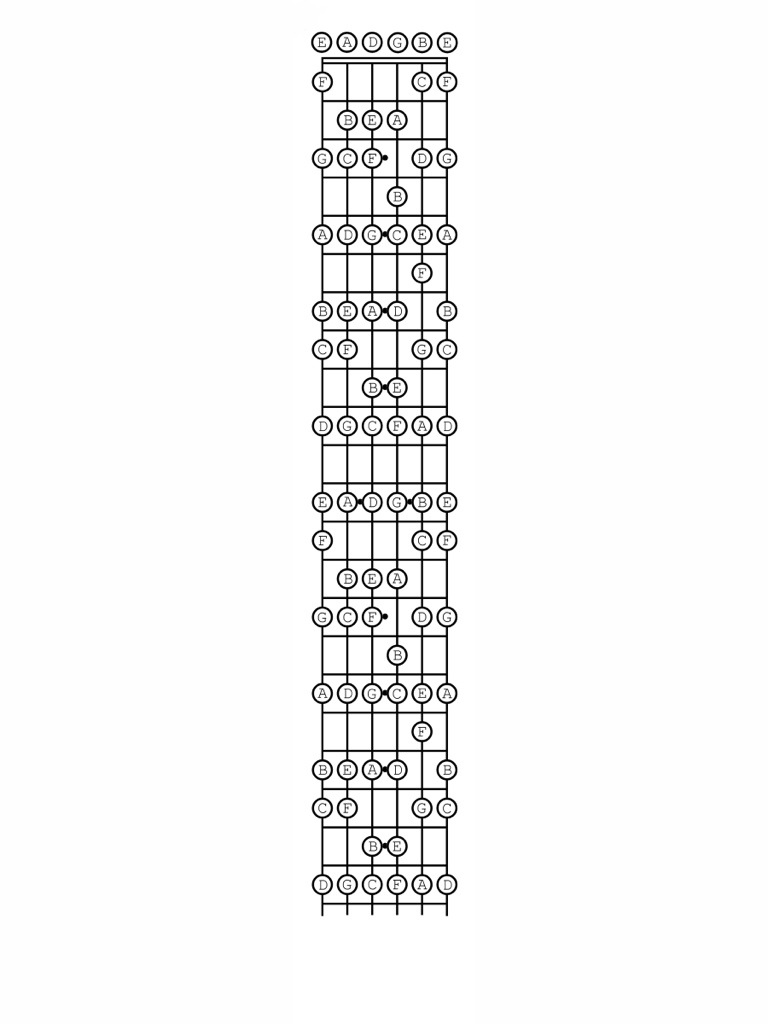The Natural Notes
Notes are named after the first seven letters of the alphabet.
A B C D E F G
Reading from left to right the notes are ascending, or going up in pitch. Reading the opposite direction, from right to left the notes are descending, or going down in pitch.
>>>>>> Up >>>>>
A B C D E F G
<<<<< Down <<<<
This sequence repeats itself:
… A B C D E F G A B C D E F G …
It goes both ways, forever in theory. In reality, there are points where our ears are unable to hear. Our human hearing is actually quite limited. But it is still enough to create all the rich music that can stir the soul.
Simple Intervals
Intervals are spaces between two notes.
Interval = Space
There are two intervals that occur between adjacent notes in the sequence of natural notes. These are the two intervals between adjacent natural notes.
They are:
the whole step (W) and
the half step (½)
A half step is an interval (or space) of one fret. A whole step is an interval of two frets.
Half Step = 1 fret
Whole Step = 2 frets
Keep in mind the implications of these notes being up and down in pitch. For example, playing up ½ step is different than playing down ½ step.
Intervals and the Alphabet
Between any two adjacent notes of the natural notes is a whole step except between B and C and between E and F, which are half steps.
A B C D E F G
All Whole steps EXCEPT
B to C = ½ step
E to F = ½ step
These intervals also have the quality of being ascending or descending (up and down respectively).
A to B = W (Whole Step)
B to C = ½ (Half Step)
C to D = W
D to E = W
E to F = ½
F to G = W
G to A = W
C is a ½ step above, or up from B.
Likewise, F is a ½ step above, or up from E.
However, C is a whole step below, or down from D.
etc.
The step would be to apply this to the guitar.
The open notes (open strings played without pressing the left hand on the fretboard) if you just pluck the strings is E, A, D, G, B and E, from the fattest, or 6th string to the thinnest, or 1st string.
Let's start with the 1st string, the little string, or E.
Strike it with the right hand with no left hand fingers and this is E.
The next note in the Music Alphabet after E is F, and E to F is an interval of 1/2 step, or 1 fret. So, if you press your left hand behind the 1st fret and striking the string with the right hand will produce an F note.
So, the open 1st string is E, and the 1st string sounded on the 1st fret is F.
The next note after F is G in the music alphabet. F to G is a whole step interval, or 2 frets. So if you press a finger on you left hand behind the 3rd fret, or 2 frets higher than the F (on fret 1) you will produce a G note.
Carrying this logic further you get this for the 1st string:
Open = E
Fret 1 = F
Fret 3 = G
Fret 5 = A
Fret 7 = B
Fret 8 = C
Fret 10 = D
Fret 12 = E
Fret 13 = F
Fret 15 = G
Etc.
Again, notice that where there are whole steps, you move up 2 frets to achieve the next note. Where there are half steps between the notes there is 1 fret between thee notes.
Use this same logic to name the notes on each string, one at a time starting with the open notes. And thus, you can learn the entire fretboard of the guitar quite simple, at least the natural notes (with no sharps or flats). Once you have mastered naming these notes, it is quite simple to learn the sharps and flat (see a future article on this).
